Checkout_my_Six
Touchdown! Greaser!
yup....that does get the allergies goin. 
Very true. Sometimes you just get dealt a bad hand.We're taught to fly it into the crash, but that doesn't always work. Sometimes you lose.
This. It takes a high degree of fortitude to simply accept a loss that strikes close to home. It makes us face our own mortality. It forces us to acknowledge that we all have a lack of agency in the face of Lady Luck.They asked Charles for his take, and he said "sometimes you just lose". You do everything right, but you still lose.
Slight correction, it was a National Air Cargo 747.Very true. Sometimes you just get dealt a bad hand.
Kind of like the Kalitta 747 in Afghanistan. Those guys were doomed when the MRAP hit the tail. They just didn’t know it yet.
Slight correction, it was a National Air Cargo 747.
NSTB says impossible turn. The investigator said 1,000 feet, a non-pilot witness said 200 feet. The eyewitness details of the person who reached the plane are a tough read. Both survived the initial impact. And they must have been so darn close to telling the story over a few cold ones. It says they hit the top of the berm and slid down.From what I’ve seen about it, they departed 32 and came up short landing 32. So the ‘impossible turn’ scenario of turning to land back opposite direction would not be it.
The guy who owns the float plane operation at Long Lake, which is probably 30 minutes from the accident site, who has countless hours as a bush pilot in the Adirondacks, told me exactly the same thing. We were flying over the mountains and I observed there were not many places to put down if you had to, he said, “Aim for the pine trees.” Of course everyone else says he’s wrong, but I would listen to him in a pinch.Not second guessing this accident, but using this airport as an example, sometimes it's best to head FOR the trees, knowing that controlled flight at a slow airspeed into the tops of trees is often very survivable, more so that a stall spin into almost anything,
NSTB says impossible turn. The investigator said 1,000 feet, a non-pilot witness said 200 feet. The eyewitness details of the person who reached the plane are a tough read. Both survived the initial impact. And they must have been so darn close to telling the story over a few cold ones. It says they hit the top of the berm and slid down.
https://www.lakeplacidnews.com/news...cid-airplane-crash-followed-engine-failure-2/
The guy who owns the float plane operation at Long Lake, which is probably 30 minutes from the accident site, who has countless hours as a bush pilot in the Adirondacks, told me exactly the same thing. We were flying over the mountains and I observed there were not many places to put down if you had to, he said, “Aim for the pine trees.” Of course everyone else says he’s wrong, but I would listen to him in a pinch.
Took off 32, tried to get back to 14.This is very true and more and more info seems to be coming out that they were really low when whatever happened.
I could be wrong, but I don't think they were trying to turn back.
Unless they are really tall trees with few lower branches, pine trees have tops to slow you down from initial contact then progressively stronger and wider branches as you drop. Deciduous trees are a little different and are less "accommodating" than pines, but even then I think you've got a better chance of survival. (Not that I've actually landed in either . . . )“Aim for the pine trees.” Of course everyone else says he’s wrong, but I would listen to him in a pinch.
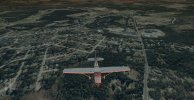
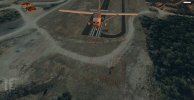
I recommend orange trees with about 12 feet of spacing between.Unless they are really tall trees with few lower branches, pine trees have tops to slow you down from initial contact then progressively stronger and wider branches as you drop. Deciduous trees are a little different and are less "accommodating" than pines, but even then I think you've got a better chance of survival. (Not that I've actually landed in either . . . )
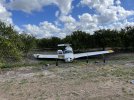
And it smells terrific!I recommend orange trees with about 12 feet of spacing between. View attachment 121200
And it smells terrific!
I suspect that it can be a bit of a crapshoot. The trees might work out fantastic or it may turn out bad.Unless they are really tall trees with few lower branches, pine trees have tops to slow you down from initial contact then progressively stronger and wider branches as you drop. Deciduous trees are a little different and are less "accommodating" than pines, but even then I think you've got a better chance of survival. (Not that I've actually landed in either . . . )
I suspect that it can be a bit of a crapshoot. The trees might work out fantastic or it may turn out bad.
I knew a student glider pilot that got into a spin at low altitude. There was a single deciduous tree that he happened to spin into which prevented him from hitting the ground and he was not seriously injured.
Another pilot at a competition apparently had a midair collision and lost control in an inverted position. The airflow prevented the canopy from opening to escape with a parachute. Apparenty, the aircraft crashed in an open field but into the only group of trees(3 of them) and it saved her.
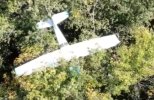
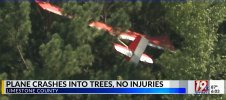
Agree completely, but always change them in your favor.Don't like the odds ... change them.
An engine needs 4 things to run: fuel, air, spark, and oil.
It also need to remain bolted together. See @hindsight2020 ’s thread about his engine.


One of the things I always brief before a takeoff is wind direction at 1000 feet. Some people will say you can make the turn back at X AGL. Okay, which way would you turn? I always have that firmly in mind before leaving earth.Agree completely, but always change them in your favor.
Look at the odds of a fatal crash when you turn back to the airport and how to manage those odds. I've seen people experiment with a simulated turn back at a safe altitude and conclude that, "I can make it back to the runway in xxhundred feet", then use that altitude as a decision point for every take-off. Nothing could be sillier, IMHO. Under some conditions there is NO altitude from which you can make it back, and under others a turn back takes you BEYOND the runway in the opposite direction. So everything in between can apply. Keeping that in mind you would need to do a complex calculation for every take off that takes into account runway length, wind direction, wind velocity, aircraft weight, density altitude, startle response delay, angle of bank, pilot proficiency, and likely other factors. I think it's safe to say that few if any pilots actually do that. Meanwhile, if the turn back is a knee-jerk response based on a target altitude you may be missing the best choice straight ahead or with a minimal turn in the runway direction.
Ok. Let's stipulate that half of engine outs are due to internal failures unlikely to be caught by anyone not named Mike Bush. The other half are due to external issues with fuel, oil, engine controls, etc that might be caught by more frequent and thorough checks with the cowl off.It also need to remain bolted together. See @hindsight2020 ’s thread about his engine.
I don't even do that. "Thumbs up" points to the up aileron during the preflight, whether using a stick or yoke. On the takeoff roll I just do the same thing and always point my thumb into the crosswind component and focus on rudders to keep aligned. It's a little unusual to have the wind at 1000 feet be from the opposite direction, but certainly it can happen and should be factored in.One of the things I always brief before a takeoff is wind direction at 1000 feet. Some people will say you can make the turn back at X AGL. Okay, which way would you turn? I always have that firmly in mind before leaving earth.
Good 'rule of thumb'...I don't even do that. "Thumbs up" points to the up aileron during the preflight, whether using a stick or yoke. On the takeoff roll I just do the same thing and always point my thumb into the crosswind component and focus on rudders to keep aligned. It's a little unusual to have the wind at 1000 feet be from the opposite direction, but certainly it can happen and should be factored in.
Yup….the thumb thing to remember.I don't even do that. "Thumbs up" points to the up aileron during the preflight, whether using a stick or yoke. On the takeoff roll I just do the same thing and always point my thumb into the crosswind component and focus on rudders to keep aligned. It's a little unusual to have the wind at 1000 feet be from the opposite direction, but certainly it can happen and should be factored in.
Where did you get that information from? The only information I can find is "the plane take off toward Cascade Acres..." which is WNW (left) of the Rwy and "..maybe 200 feet, he saw the plane take a sharp right" which would be logical, but not a sharp left.The 177 made a hard left turn after takeoff
https://www.lakeplacidnews.com/news...cid-airplane-crash-followed-engine-failure-2/Hi everyone.
Where did you get that information from? The only information I can find is "the plane take off toward Cascade Acres..." which is WNW (left) of the Rwy and "..maybe 200 feet, he saw the plane take a sharp right" which would be logical, but not a sharp left.
I hope we can get more information to analyze and learn something from this accident, so far very little useful information.
I cannot see / find any of the "..berm at the end of the runway and fell around 30 feet into a ravine..." around the end of the Rwy?
Great analysis, RonHere's the aircraft vs. accident data I used for the computation:
View attachment 121106
"All" is the total aircraft on the registry as of the end of the given year. The year itself is calendar year, not fiscal year (the FAA publishes figures based on fiscal year).
It's interesting to note that one can get different numbers of accidents per year depending on what source one uses. For 2021, for example, if you use the online tool, the total comes out to over 1700, vs. the 1635 shown above. I extract my numbers from the NTSB accident database I downloaded on 1 December 2022.
Accidents which receive an NTSB number (e.g., "NYC08CA089") and are included in the NTSB accident database are counted. I presume that these are considered accidents because the criteria in NTSB Part 830 are met.
As I mentioned earlier, this includes some foreign accidents, accidents in the US involving foreign-registered aircraft, and unregistered air vehicles. In addition, separate accidents occurring to a given aircraft will also be counted separately.
Certainly, there are some silly accidents in the database, but I suspect the number of stall-spin cases FAR exceeds the instances where a drunk driver drove through a hangar. In any case, the drunk-driving-into-the-hangar incident would not be considered a reportable accident, per NTSB 830.2:
Aircraft accident means an occurrence associated with the operation of an aircraft which takes place between the time any person boards the aircraft with the intention of flight and all such persons have disembarked, and in which any person suffers death or serious injury, or in which the aircraft receives substantial damage.
If the drunk drove into an *occupied* aircraft, then yes, it would be assigned an NTSB number. For example, a case where a guy with a fork lift drove into a 172 (ANC00LA005).
Should also point out that the figures I posted are based on *all registered aircraft being active*. The a recent annual FAA General Aviation Survey says that less than 80% of the single-engine piston-powered aircraft in the registry are active. Include THAT, and the rate drops from one accident per 175 aircraft to one in 140.
Just remember: It ain't random. You can reduce your risks by trying to fly safe.
Ron Wanttaja
The reduction was (mostly) administrative. After 9/11, Congress got upset with the FAA because the FAA couldn't contact too many airplane owners...generally airplanes that had been scrapped years earlier. FAA's response was to institute the requirement that all aircraft owners would have to re-register their airplanes every three years (recently changed to seven years).Great analysis, Ron
Numbers like this scare me a bit but being a little scared helps to keep me on my toes.
The following observation belongs in a different thread, but I couldn't help but notice the 23.5% reduction in the supply of registered aircraft since the peak in 2008. Surely this is a big factor in the increasing unaffordability of aircraft these days.

Highlighted houses?Hi everyone.
I think we need to wait for better data before we can analyze.
I posted a couple of more pics just in case someone can pinpoint a closer location.
View attachment 121241View attachment 121242
Possible scenario is hard left, followed by right turn back toward the runway. This would be more consistent with sparse witness information so far.https://www.lakeplacidnews.com/news...cid-airplane-crash-followed-engine-failure-2/
The crash happened around 4:05 p.m. Sunday at the end of a runway, close to the North Elba Athletic Fields and Recycle Circle Lane, shortly after takeoff after “a hard roll to the left,” according to initial NTSB reporting.
Edit: this article contains conflicting accounts, unless I'm missing something. Just how many eyewitness statements are there? Also, different witnesses can remember things differently.
That's certainly consistent with a typical "180" back to the runway. Once you complete the 180 you've got another big turn in the opposite direction to come close to the runway itself. (That's one other reason the proving to yourself that a 180 degree turn uses only xxx feet of altitude is a completely useless metric when used to determine a safe "turn-back" altitude, yet I see people use it frequently.)Possible scenario is hard left, followed by right turn back toward the runway. This would be more consistent with sparse witness information so far.
